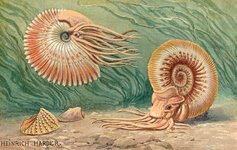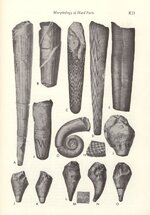You are using an out of date browser. It may not display this or other websites correctly.
You should upgrade or use an alternative browser.
You should upgrade or use an alternative browser.
Discussion of the Reconstructions of Nautiloids and Ammonoids
- Thread starter Phil
- Start date
- Joined
- Nov 19, 2002
- Messages
- 3,031
I've just added Polyptychoceras. Not much info to go on as most of it seems to be restricted to Japanese websites and research papers one can't access for free.
I tried to keep the entries roughly chronological, but it's getting difficult to manage as sometimes they have to be inserted into a block which has reached it's image capacity.
I tried to keep the entries roughly chronological, but it's getting difficult to manage as sometimes they have to be inserted into a block which has reached it's image capacity.
- Joined
- Apr 4, 2008
- Messages
- 24
Phil;43583 said:ammonite with striped pigment bands still showing. I'll see if I can scan it tonight for you. In truth, no-one really knows how they were decorated.
As for depictions of nautiloids with reddish-brown striped patterns I'm sure they are just extrapolated from Nautilus.
Actually, older nautiloids have been found with color-patterns surprisingly similar to modern Nautilus (don't ask me for details, I read this years ago). Coincidence? More likely that the group was very conservative. I'd bet the ammonoids were far less conservative, but have only heard of the one (early Triassic, Nevada) with color bands... was it Subvishnuites welteri? Preservation is all when it comes to color... the specimen must be original shell. Maybe some of those nice Pierre Shale, Fox Hills Sandstone, Hornby Island or southern Alberta specimens might respond to UV or other methods of checking for color patterns?
- Joined
- Apr 4, 2008
- Messages
- 24
Phil;43589 said:The lower image is of the Miocene nautiloid Aturia and one can make out a trace of patterning very similar to Nautilus. With the ammonite the patterning resembles a snail rather than the familiar Nautilus patternation.
Thanks!
The apparent "color pattern" on the Aturia is actually not. It is something to do with the shell structure; I have seen it on various Miocene specimens, and it can be seen to be the shell surface located between the septa. It may be due to translucence of the thinnest part of the shell allowing the matrix within to show through. None of the New Zealand Eocene or Oligocene specimens I have seen show this, but their preservation differs from the NZ Miocene ones.
- Joined
- Mar 8, 2004
- Messages
- 4,883
 to TONMO
to TONMOI thought I remembered that part of the lack of patterns was that the actual shell material is rarely preserved, but I know that occasionally even proteins in the shell have survived, which doesn't seem consistent with a loss of the shell patterning... hmmm...
- Joined
- Apr 4, 2008
- Messages
- 24
Allonautilus;81819 said:Some sources say that aptychi are elaborate lids, while others say "jaw apparatus". By that word, are they actually parts of ammonite's beak, or even analogous to coleoid beaks?
Aptychi are found in Jurassic-and-later ammonoids. They are 2-piece and close the aperture nicely. Anaptychi are one-piece and are found in phylloceratids and Triassic-and-older ammonoids, and are the lower mandibles of these beasts. They may well fit over the aperture, with the tip against the early part of the whorl (where the "black band" in Nautilus ends). Whether they had a dual function (operculum and biting) I don't know.
- Joined
- Apr 4, 2008
- Messages
- 24
monty;114313 said:to TONMO
I thought I remembered that part of the lack of patterns was that the actual shell material is rarely preserved, but I know that occasionally even proteins in the shell have survived, which doesn't seem consistent with a loss of the shell patterning... hmmm...
Shell matter being recrystallized or replaced (or just dissolved and left as empty space) is common enough with ammonoids, but in some horizons the original shell is preserved (beautifully nacreous). I have been through my own collection and the local university's geology department, with both normal light and UV, and have found that a significant but small proportion of specimens of Cenozoic gastropods, all original shell, show at least faint hints of color-pattern, most only under UV. Some of the best examples were badly leached. But specimens of a single species from the same horizon at the same locality are inconsistent; one may show a pattern clearly and another partially or not at all. A student doing a master's has shown that the pattern is not organic, but some inorganic chemical which replaces the pigment or is a result of pigment breakdown.
- Joined
- Apr 4, 2008
- Messages
- 24
I am a fossil preparator at the University of Otago, Dunedin, New Zealand. A few years ago I worked with an artist who was painting scenes from 4 periods for a major fossil display at the regional museum. One was a specimen of an Eocene Aturia cruising along. As the color-patterns (if any) of the members of the genus are unknown, I decided that spiral bands would be a nice contrast to its ancestor, Nautilus. There is one problem with reconstructing the animal of Aturia. If you look at a shell in good condition, you may not something that is never mentioned in the literature. Look at the growthlines. They tell you that either the shell has a huge hyponomic (siphonal) sinus or it has big lappets. I would say that it's the latter, as I doubt that it had a huge hyponome... unless it was the boy-racer of the Cenozoic nautiloids. This raises the question of eye location; there is no ocular sinus, so, unlike Nautilus, there is no hint in the shell as to where the eyes were located. In front of the lappets? Wierd. Behind? Above... on long stalks?
 to TONMO vw1,
to TONMO vw1,Dieneroceras from the Triassic in Nevada have spiral color markings while paranannites and owenites have radial color bands. The radial bands may be explained much like the dark bands found on modern captive nautilus, see this paper.
The spiral color pattern seems to me at least to be an actual color pattern.
Some pictures of these Triassic ammonoids can be found in
Triassic ammonoids: A photographic journey
James F. Jenks, Justin A. Spielmann and Spencer G. Lucas
Pages 33–80 PDF (30.9 MB)
plate 1 for Dieneroceras, plate 3 for Paranannites.
The Treatise on Invertebrate Paleontology, Part K, Mollusca 3, Cephalopoda "Nautiloids" 1964, University of Kansas Press and Geological Society of America, has a page (K23) showing some of the color markings on fossil cephalopods.
Attachments
The PaleoNet pages Gallery has a new exhibition with some drawings of nautiloids, see: Back to the Past, by Enrico Bonino. Its on the home page, I cant link to the actual gallery.
- Joined
- Mar 8, 2004
- Messages
- 4,883
Architeuthoceras;131941 said:The PaleoNet pages Gallery has a new exhibition with some drawings of nautiloids, see: Back to the Past, by Enrico Bonino. Its on the home page, I cant link to the actual gallery.
The gallery is here, if this works:
http://www.nhm.ac.uk/hosted_sites/paleonet/vop/bonino/index.html
cool pics!
Thanks Monty, it just kept going back to the home page for me. 
2 new reconstructions of Pravitoceras by Eric in the gallery here, this old comment still applies.
I still cant picture how that thing would swim around if it was rotated 180
Architeuthoceras;42040 said:Only one, Pravitoceras, could be fixed, and I dont have a clue as how to fix itThe early whorls are coiled normally so the venter would be towards the outside (or the convex side) of the shell. At maturity it coils the opposite direction so the venter would now be on the inside (or the concave side). Most ammonites (according to a Nautilus model) are oriented with the funnel ventral, and the eyes dorsal (? is this the same with squid & octopuses), just the opposite of the reconstruction, unless the animal twisted 180 degrees in it's shell. Of course if you drew it that way it would look upside down. Anything that grew a weird shell like that was bound to be peculiar to start with.
I still cant picture how that thing would swim around if it was rotated 180
Similar threads
- Replies
- 0
- Views
- 705
- Replies
- 7
- Views
- 3K
- Replies
- 0
- Views
- 1K
- Replies
- 1
- Views
- 208


